KolibriOS: Interview with Sergey Kuzmin (Wildwest)
Meet the corporate user of the KolibriOS blog . On behalf of this user, articles written by freelance authors in the framework of the KolibriOS Blog is looking for authors , as well as project participants who do not have a user on Habr, or who do not want to publish articles on their own behalf, will be published.
As the first publication, we bring to your attention an interview with Sergey Kuzmin (nickname Wildwest), one of the “old-timers” in the KolibriOS project (on Khabr W__W ).
1. Tell us about yourself, who you are and where from? What do you do?
I teach in one of the universities of St. Petersburg - I conduct laboratory and workshops, give lectures. In science, I am engaged in algorithms for the automatic analysis of video information for computer vision systems and applied television. He wrote more than 40 articles, last year he became a co-author of the monograph. Since the opening of Coursera (spring 2012), I have been following technical and IT courses: I just download some in the hope of someday watching, while I study on others - I received certificates from three professors in the field of computer vision - Jitendra Malik, Guillermo Sapiro, Irfan Essa.
2. How long have you been in this project?
I found out about it ( MenuetOS - editor's note ) from the print version of the article www.comprice.ru/articles/detail.php?ID=43137in the second half of July 2003.
A few weeks later I went online, went to menuet.narod.ru , downloaded various distributions. The first I decided to launch the German Gerschi distribution ( menuet.narod.ru/arch2003_3.htm ). He looked very colorful.

When after a while I launched the official distribution, I was unpleasantly surprised - it looked less groomed. Then I did not have stable access to the Internet, so I could only visit the project sites once every few weeks. In 2004, with the onset of summer, I began to participate in discussions at the Russian-language forum, and in the fall, in discussions at English-speaking forums. Then he began to deal with CPUID and other things, which are described later.
3. What are you doing in the KolibriOS project?
In the MenuetOS and KolibriOS projects, I was engaged in those programs that were not completed at that time, as well as journalistic, advertising, and human rights activities. I'll tell you in order:
MenuetOS had a program for displaying the processor frequency. I decided to develop it and gradually appearedCPUID - processor performance display program. At first, the program interface was constantly changing, but then it stabilized.
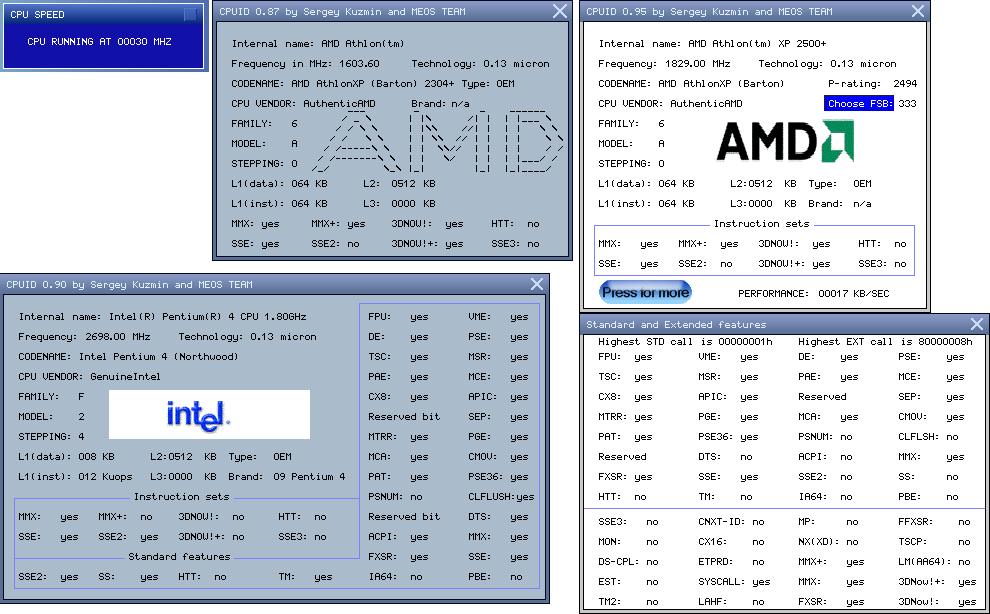
During development, an inaccuracy was discovered in the kernel of the OS , and I got to the list of MenuetOS developers. Then the program also entered the distribution kit( CPUID - editor's note ). In 2006-2007, it was already a very solid program, comparable to CPU-Z. Apparently, this was the first program for MenuetOS / KolibriOS, in which the program interface changed depending on the detected iron. For Intel processors there was a regular interface, and for AMD there were additional elements - a button for selecting a bus frequency (a system bus frequency detection had not yet been made) and an inscription with a calculated performance rating (in the upper right figure). It should be noted that many people helped test this program and wrote code for it, helped with the design (@Heavyiron, Leency , Mario_Z , Ghost_nsk , halyavin , grechnik) An interesting trick was associated with a beautiful button for invoking the second window - an image is drawn on top of the button, and if the user clicks on the image, a button click will be generated. Outwardly, it looked like a button with a skin, but in fact it was two different components.
Then there was PCIDEV , a project launched by an American. It simply displayed a lot of numbers without decryption and the device class. I started decoding the numbers into an understandable description - the names of the companies, the detailed purpose of the device. Other developers have joined in this process. Now it is one of the most useful programs.
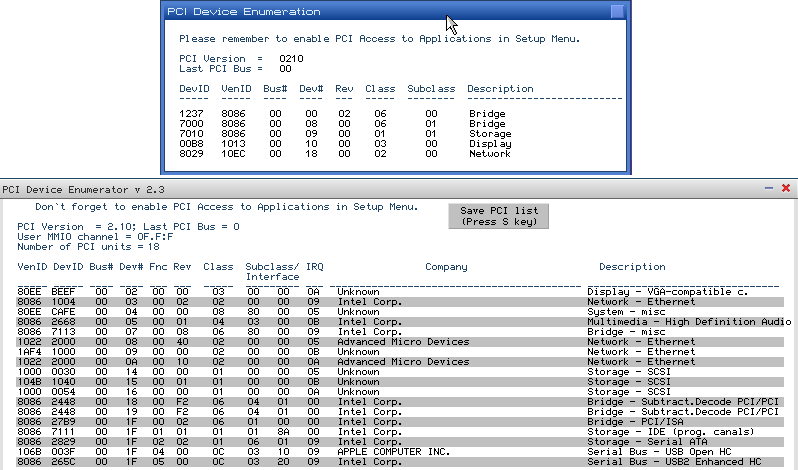
Next Modified Program - Tetriswritten by italian. For him, I paused, because during the game I often had to be distracted, and did not want to lose points. I paused quickly, so I looked at the resulting cheat: during a pause, you can rotate the figure and move it left and right. Whoever fixes the cheat will be great (you need to put checks on being in game mode or pause in the keyboard processing cycle).
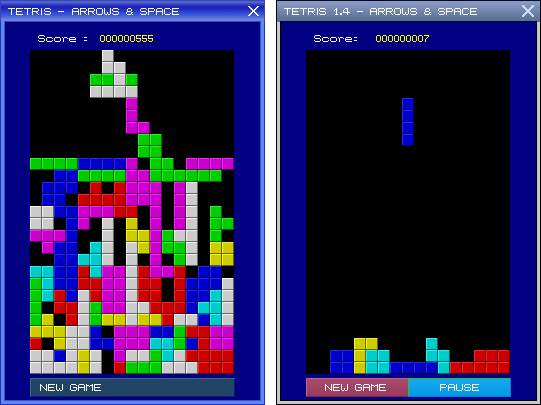
There was still an unfinished project SuperMP3 - a blank for a music player mp3 files. Other developers also participated in it, but in the end everything stopped, because there was still poor support for sound cards.
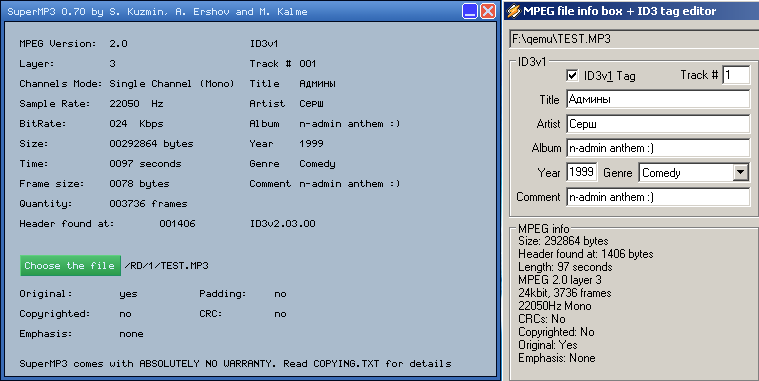
My journalistic activity began with the fact that I posted news of alternative operating systems on my website, and in them I paid a lot of attention to KolibriOS. I also commented on this news, so the news page was a blog in some way. I interviewed the leaders of the project: I talked a little with the Finnish Ville Turyanmaa (founder of MenuetOS), the Englishman Mike Hibbet , the Pole Yaroslav Peltsar , the Belarusian Mikhail Semenyako (aka mike.dld ) and Marat Zakiyanov (aka Mario79, aka Mario_Z , aka Mario_r4 ). Marat then asked to remove the interview with him from my site. He paid much attention to translations of various articles and the history of Menuet / KolibriOS (biggest article ).
As part of the advertising, the OS published two articles in print ( www.comprice.ru/articles/detail.php?ID=42992 , samag.ru/archive/article/1742 ) and one more in electronic . When the OS was released, many of our team went to computer forums and sites to write about it.
(A small digression hidden under the spoiler - editor's note)
In May 2006, I began to engage in my program for analyzing video information, actively writing articles on computer vision. Gradually, less and less time remained on Kolibri. As a result, in the fall of 2007, I stopped developing for her, but continued from time to time to go to the project’s forum and wiki. Recently I was asked to add support for modern processors to the CPUID program . I’ll also try to rummage through my hard drives: apparently, many programs are simply forgotten, including a screensaver with geometric shapes - a masterpiece of the demoscene.

4. What attracts you to it? Why?
When I saw her, I felt a great contrast with the then Linux distributions. It fit on several CDs, it required re-partitioning of the hard drive, the programs depended on a bunch of libraries ... MenuetOS in this regard was compact and unpretentious. Then I really liked the community. I tried many Axes, participated in some communities (the Russian keyboard layout in Syllable appeared at my request) and I can say that, compared to them, the MenuetOS / KolibriOS commands were much more active, international and responsive.
Many articles, FAQs were published, contests for the creation of logos and programs were held, then electronic journals began to be issued. Programming for this OS was initially not very attractive, but macros and widget libraries gradually appeared. They speed up application development several times. The API is still evolving - support for working with USB devices has recently appeared . Several KolibriOS API emulators have been developed to run programs on other operating systems. It is relatively easy to change any part of the operating system.
5. What future do you see with this OS?
There was initially a problem with the OS concept - Ville made a conceptual OS, and, after proving the concept, the need for some further development actions, apparently, became not so obvious to him. Therefore, he gladly began to deal with the 64-bit version - a new goal appeared. But in the end, nothing special happened either, including due to the closed source code. In this regard, collective development is often more productive, because everyone’s goals are a bit different and a universal product is obtained. On the other hand, the number of distributions and forks specialized for industrial use is growing. This, in general, is also a positive process, if the bugs found in these distributions are described on the project forum and fixed in the main distribution. There’s no point in talking about competition between distributions at this stage,
We have a problem with the project leader in recent years. After diamond 'a ( grechnik ) left, not a single distribution kit was released. There are only regularly updated nightly builds . But it seems to me that it will be released in the coming months, because soon 1 million lines ( not counting the C libraries, because of which the total number of lines is incorrectly displayed - editor's note ), and the Kolibri Summer Of Code ends .
The community is constantly growing, especially after creating a group on social networks ( for English-speaking users, a group was created on Facebook - editor's note) There are first-class programmers in the project - our two developers ( hidnplayr , Mario79 ) are constantly featured in the Recently Active Contributors top on Ohloh . The same link shows that there are a lot of projects in assembler, and we can hope for the arrival of new people.
Regarding the industrial purpose of the OS - I will name five examples (the rest are described on our forum ):
(In the photo below - factory use for the SCADA system)

For a long time, the issue of embedding KolibriOS in the BIOS has been discussed , which will give certain opportunities to both programmers and users. ( Although there is already even one working example - editor's note. )
Thus, with hands and knowledge, KolibriOS can be adapted to any task.
Finally - atmospheric pictures of fans: mine and South American.
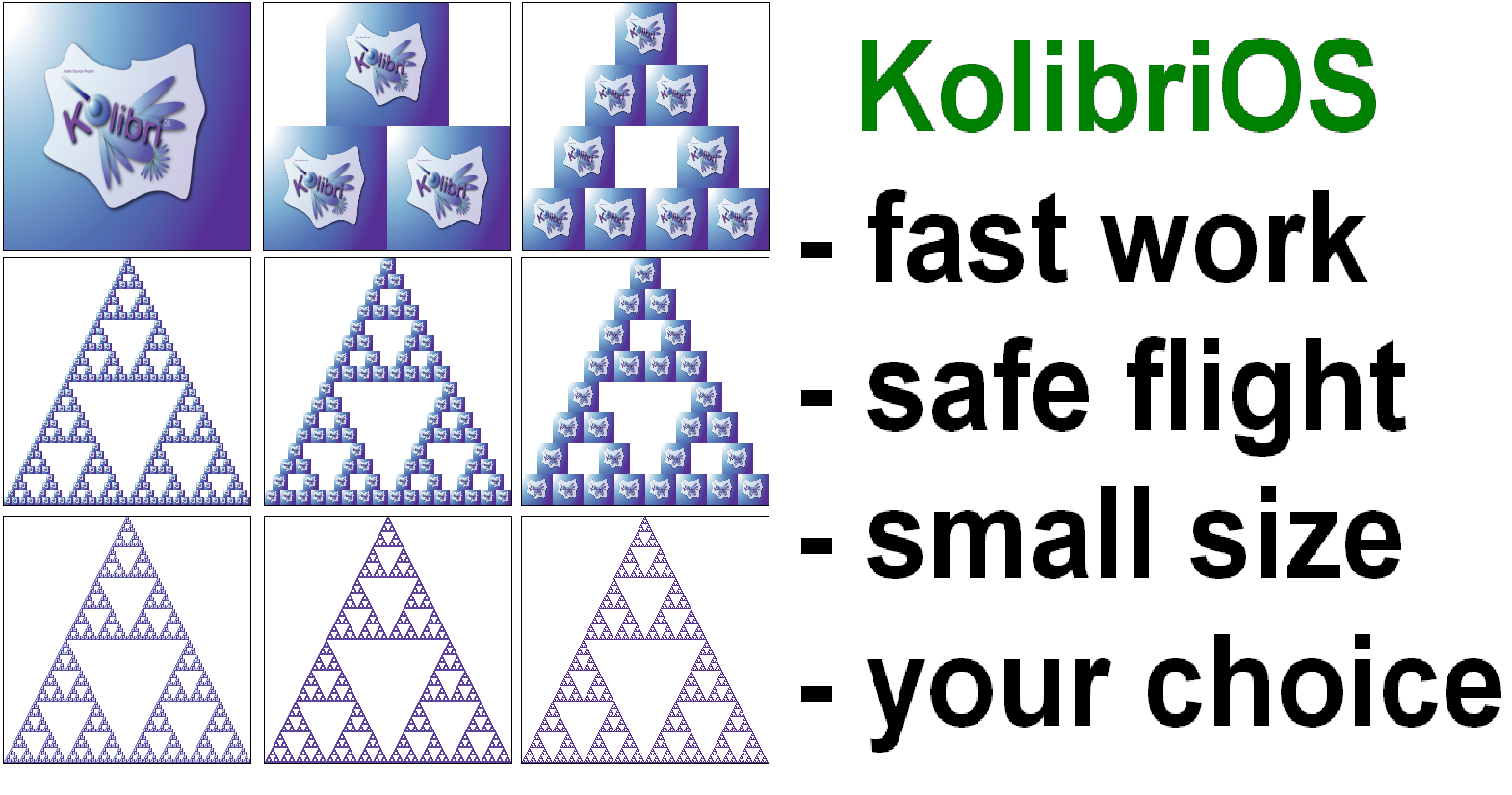

As the first publication, we bring to your attention an interview with Sergey Kuzmin (nickname Wildwest), one of the “old-timers” in the KolibriOS project (on Khabr W__W ).
1. Tell us about yourself, who you are and where from? What do you do?
I teach in one of the universities of St. Petersburg - I conduct laboratory and workshops, give lectures. In science, I am engaged in algorithms for the automatic analysis of video information for computer vision systems and applied television. He wrote more than 40 articles, last year he became a co-author of the monograph. Since the opening of Coursera (spring 2012), I have been following technical and IT courses: I just download some in the hope of someday watching, while I study on others - I received certificates from three professors in the field of computer vision - Jitendra Malik, Guillermo Sapiro, Irfan Essa.
2. How long have you been in this project?
I found out about it ( MenuetOS - editor's note ) from the print version of the article www.comprice.ru/articles/detail.php?ID=43137in the second half of July 2003.
A few weeks later I went online, went to menuet.narod.ru , downloaded various distributions. The first I decided to launch the German Gerschi distribution ( menuet.narod.ru/arch2003_3.htm ). He looked very colorful.

When after a while I launched the official distribution, I was unpleasantly surprised - it looked less groomed. Then I did not have stable access to the Internet, so I could only visit the project sites once every few weeks. In 2004, with the onset of summer, I began to participate in discussions at the Russian-language forum, and in the fall, in discussions at English-speaking forums. Then he began to deal with CPUID and other things, which are described later.
3. What are you doing in the KolibriOS project?
In the MenuetOS and KolibriOS projects, I was engaged in those programs that were not completed at that time, as well as journalistic, advertising, and human rights activities. I'll tell you in order:
MenuetOS had a program for displaying the processor frequency. I decided to develop it and gradually appearedCPUID - processor performance display program. At first, the program interface was constantly changing, but then it stabilized.

During development, an inaccuracy was discovered in the kernel of the OS , and I got to the list of MenuetOS developers. Then the program also entered the distribution kit( CPUID - editor's note ). In 2006-2007, it was already a very solid program, comparable to CPU-Z. Apparently, this was the first program for MenuetOS / KolibriOS, in which the program interface changed depending on the detected iron. For Intel processors there was a regular interface, and for AMD there were additional elements - a button for selecting a bus frequency (a system bus frequency detection had not yet been made) and an inscription with a calculated performance rating (in the upper right figure). It should be noted that many people helped test this program and wrote code for it, helped with the design (@Heavyiron, Leency , Mario_Z , Ghost_nsk , halyavin , grechnik) An interesting trick was associated with a beautiful button for invoking the second window - an image is drawn on top of the button, and if the user clicks on the image, a button click will be generated. Outwardly, it looked like a button with a skin, but in fact it was two different components.
Then there was PCIDEV , a project launched by an American. It simply displayed a lot of numbers without decryption and the device class. I started decoding the numbers into an understandable description - the names of the companies, the detailed purpose of the device. Other developers have joined in this process. Now it is one of the most useful programs.

Next Modified Program - Tetriswritten by italian. For him, I paused, because during the game I often had to be distracted, and did not want to lose points. I paused quickly, so I looked at the resulting cheat: during a pause, you can rotate the figure and move it left and right. Whoever fixes the cheat will be great (you need to put checks on being in game mode or pause in the keyboard processing cycle).

There was still an unfinished project SuperMP3 - a blank for a music player mp3 files. Other developers also participated in it, but in the end everything stopped, because there was still poor support for sound cards.

My journalistic activity began with the fact that I posted news of alternative operating systems on my website, and in them I paid a lot of attention to KolibriOS. I also commented on this news, so the news page was a blog in some way. I interviewed the leaders of the project: I talked a little with the Finnish Ville Turyanmaa (founder of MenuetOS), the Englishman Mike Hibbet , the Pole Yaroslav Peltsar , the Belarusian Mikhail Semenyako (aka mike.dld ) and Marat Zakiyanov (aka Mario79, aka Mario_Z , aka Mario_r4 ). Marat then asked to remove the interview with him from my site. He paid much attention to translations of various articles and the history of Menuet / KolibriOS (biggest article ).
As part of the advertising, the OS published two articles in print ( www.comprice.ru/articles/detail.php?ID=42992 , samag.ru/archive/article/1742 ) and one more in electronic . When the OS was released, many of our team went to computer forums and sites to write about it.
(A small digression hidden under the spoiler - editor's note)
A Brief History of Separating KolibriOS from MenuetOS
Летом 2004 года Вилле готовился к переезду в Париж, и назначил руководителем проекта Хиббета. Хиббет через некоторое время пропал, и появилась необходимость сменить руководителя проекта. Надо отметить, что в 2003-2005 годах на нашем форуме регулярно выкладывались новые фиксы, драйверы и программы, в том время как на официальном форуме большинство разработок касалось интерфейса, перевода и прочего моддинга ОС. Часть из наших разработок анонсировалась на официальном форуме и форуме компилятора FASM, но в дистрибутив не попадали, т.к. сами дистрибутивы собирались довольно редко и, видимо, из того, что присылали руководителям проекта на почту.
В это непростое время я, вместе с другими членами нашей команды (Sniper, Mario79), пытался донести до Вилле и англоязычного сообщества мысль, что большинство реальных разработчиков MenuetOS находятся в странах бывшего СССР, и надо назначить руководителем проекта человека, который хорошо знает английский и русский языки. В общем, защищал права «советских» разработчиков. Наша команда видела в этой роли mike.dld, у которого были хорошие отношения с Вилле, и он также был в нашей команде. Это так и не удалось сделать: руководителем был назначен Пельцар, потом голосованием на официальном форуме его кандидатуру многие поддержали. Потом Пельцар ушёл, и проект остался без руководителя вообще.
Самого Вилле ситуация с Menuet32 в этот момент уже мало интересовала, т.к. он занимался Menuet64 и регулярно выкладывалновые скриншоты. Отсутствие руководителя и регулярных официальных релизов дало новый импульс развитию дистрибутивов, одним из которых и был Kolibri. (Были также другие русскоязычные дистрибутивы, из которых Menuet RE долгое время считался основным, но потом его разработчик Иван Поддубный исчез.)
Когда, через некоторое время, Вилле снова объявился и сказал, что 32-х битная ветка закрывается, и всем надо писать программы для Menuet64, то большинство разработчиков его не поддержало. Наша команда несколько дней с ним спорила на форуме, а потом просто объявила о своей независимости и переименовании дистрибутива Kolibri в операционную систему KolibriOS. Вилле это не понравилось, и потом он ещё много раз писал, что мы украли его код, а также удалял темы о KolibriOS на контролируемых им форумах. В итоге было добавлено упоминание MenuetOS в загрузочный экран, и проставлены копирайты в файлах ядра. (Упоминание на загрузочном экране было убрано CleverMouse в ревизии #3759 4 июля 2013 г., спустя почти 10 лет после того, как оно было добавлено, так как, по её словам, "в Колибри осталось менее 20% функциональности Менуэта" — прим. редактора.)
В это непростое время я, вместе с другими членами нашей команды (Sniper, Mario79), пытался донести до Вилле и англоязычного сообщества мысль, что большинство реальных разработчиков MenuetOS находятся в странах бывшего СССР, и надо назначить руководителем проекта человека, который хорошо знает английский и русский языки. В общем, защищал права «советских» разработчиков. Наша команда видела в этой роли mike.dld, у которого были хорошие отношения с Вилле, и он также был в нашей команде. Это так и не удалось сделать: руководителем был назначен Пельцар, потом голосованием на официальном форуме его кандидатуру многие поддержали. Потом Пельцар ушёл, и проект остался без руководителя вообще.
Самого Вилле ситуация с Menuet32 в этот момент уже мало интересовала, т.к. он занимался Menuet64 и регулярно выкладывалновые скриншоты. Отсутствие руководителя и регулярных официальных релизов дало новый импульс развитию дистрибутивов, одним из которых и был Kolibri. (Были также другие русскоязычные дистрибутивы, из которых Menuet RE долгое время считался основным, но потом его разработчик Иван Поддубный исчез.)
Когда, через некоторое время, Вилле снова объявился и сказал, что 32-х битная ветка закрывается, и всем надо писать программы для Menuet64, то большинство разработчиков его не поддержало. Наша команда несколько дней с ним спорила на форуме, а потом просто объявила о своей независимости и переименовании дистрибутива Kolibri в операционную систему KolibriOS. Вилле это не понравилось, и потом он ещё много раз писал, что мы украли его код, а также удалял темы о KolibriOS на контролируемых им форумах. В итоге было добавлено упоминание MenuetOS в загрузочный экран, и проставлены копирайты в файлах ядра. (Упоминание на загрузочном экране было убрано CleverMouse в ревизии #3759 4 июля 2013 г., спустя почти 10 лет после того, как оно было добавлено, так как, по её словам, "в Колибри осталось менее 20% функциональности Менуэта" — прим. редактора.)
In May 2006, I began to engage in my program for analyzing video information, actively writing articles on computer vision. Gradually, less and less time remained on Kolibri. As a result, in the fall of 2007, I stopped developing for her, but continued from time to time to go to the project’s forum and wiki. Recently I was asked to add support for modern processors to the CPUID program . I’ll also try to rummage through my hard drives: apparently, many programs are simply forgotten, including a screensaver with geometric shapes - a masterpiece of the demoscene.

4. What attracts you to it? Why?
When I saw her, I felt a great contrast with the then Linux distributions. It fit on several CDs, it required re-partitioning of the hard drive, the programs depended on a bunch of libraries ... MenuetOS in this regard was compact and unpretentious. Then I really liked the community. I tried many Axes, participated in some communities (the Russian keyboard layout in Syllable appeared at my request) and I can say that, compared to them, the MenuetOS / KolibriOS commands were much more active, international and responsive.
Many articles, FAQs were published, contests for the creation of logos and programs were held, then electronic journals began to be issued. Programming for this OS was initially not very attractive, but macros and widget libraries gradually appeared. They speed up application development several times. The API is still evolving - support for working with USB devices has recently appeared . Several KolibriOS API emulators have been developed to run programs on other operating systems. It is relatively easy to change any part of the operating system.
5. What future do you see with this OS?
There was initially a problem with the OS concept - Ville made a conceptual OS, and, after proving the concept, the need for some further development actions, apparently, became not so obvious to him. Therefore, he gladly began to deal with the 64-bit version - a new goal appeared. But in the end, nothing special happened either, including due to the closed source code. In this regard, collective development is often more productive, because everyone’s goals are a bit different and a universal product is obtained. On the other hand, the number of distributions and forks specialized for industrial use is growing. This, in general, is also a positive process, if the bugs found in these distributions are described on the project forum and fixed in the main distribution. There’s no point in talking about competition between distributions at this stage,
We have a problem with the project leader in recent years. After diamond 'a ( grechnik ) left, not a single distribution kit was released. There are only regularly updated nightly builds . But it seems to me that it will be released in the coming months, because soon 1 million lines ( not counting the C libraries, because of which the total number of lines is incorrectly displayed - editor's note ), and the Kolibri Summer Of Code ends .
The community is constantly growing, especially after creating a group on social networks ( for English-speaking users, a group was created on Facebook - editor's note) There are first-class programmers in the project - our two developers ( hidnplayr , Mario79 ) are constantly featured in the Recently Active Contributors top on Ohloh . The same link shows that there are a lot of projects in assembler, and we can hope for the arrival of new people.
Regarding the industrial purpose of the OS - I will name five examples (the rest are described on our forum ):
- MenuetOS / KolibriOS was put into an ATM, and, in principle, it is quite realistic to write the corresponding banking software;Under the spoiler - Photo MenuetOS, working in an ATM
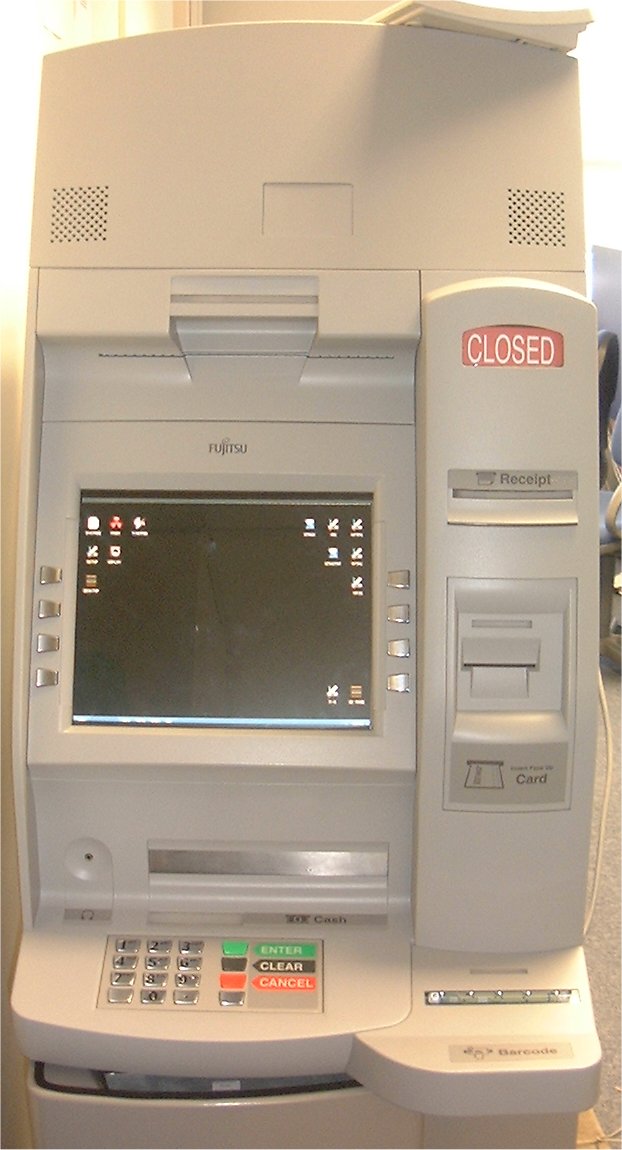
- used at the factory for the SCADA system;
- performed numerical simulation of spectra for radiophysics problems (Mössbauer spectroscopy) and even defended a dissertation - vak2.ed.gov.ru/idcUploadAutoref/renderFile/80179 (the CMspectra program was first written for KolibriOS, then ported to other operating systems - co-author Andrey Ignatiev, aka andrew_programmer );
- used on a server for a cartographic (GIS) server ( more );
- on railway transport for automatic monitoring of the condition of
rails( contact cable - editor's note ) based on the analysis of video information from a passing train (described in more detail in the comment below , the original is on our forum ).
(In the photo below - factory use for the SCADA system)

For a long time, the issue of embedding KolibriOS in the BIOS has been discussed , which will give certain opportunities to both programmers and users. ( Although there is already even one working example - editor's note. )
Thus, with hands and knowledge, KolibriOS can be adapted to any task.
Finally - atmospheric pictures of fans: mine and South American.


